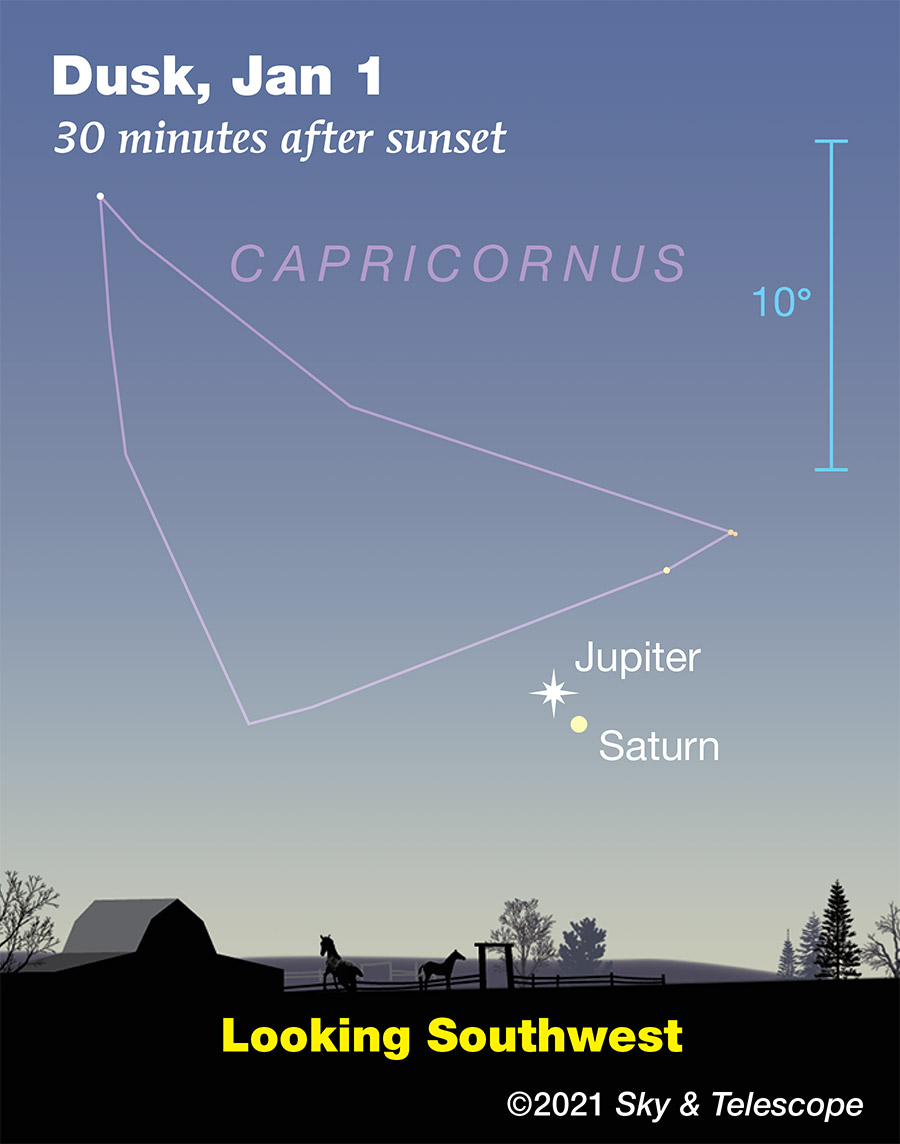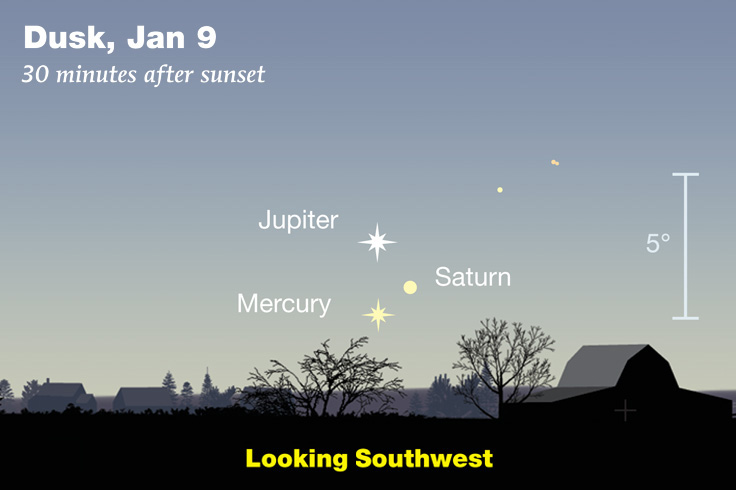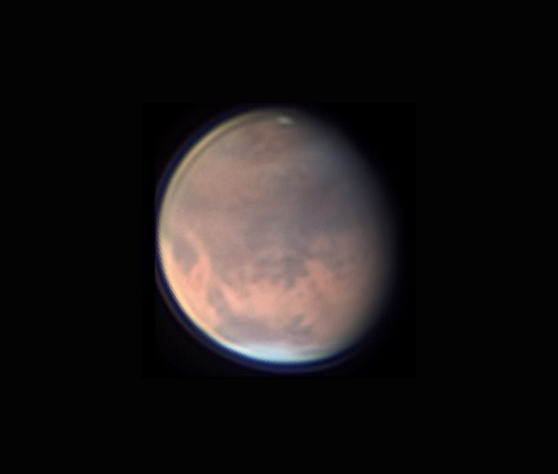
FRIDAY, JANUARY 1
■ As Jupiter and Saturn continue to draw apart, they're sinking ever lower in the southwest in twilight as shown above. This evening they're 1.3° apart. How much longer can you keep them in view?
SATURDAY, JANUARY 2
■ Just as the stars come out, face due north and look high. Cassiopeia is now a flattened M shape canted at an angle (depending on where you live). Only an hour or so later, the M is horizontal! Why? Constellations passing near the zenith appear to rotate rapidly with respect to your direction "up."
■ The Quadrantid meteor shower is predicted to peak in the hours before dawn January 3rd, though mostly for the longitudes of the West Coast (that's because this shower's peak lasts just a few hours, and it's predicted to be centered around 14:30 UT; 6:30 a.m. Pacific Standard Time). The light of the waning gibbous Moon will dilute your view of the fainter meteors, but the occasional bright one should shine through.
SUNDAY, JANUARY 3
■ By early January Orion has fully come into his own. He's now striding up the east-southeastern sky as soon as it gets dark, with his three-star Belt nearly vertical.
Left of the Belt is orange Betelgeuse marking Orion's eastern shoulder. Right of the Belt is bright white Rigel, his leading foot. The Belt points high up toward Aldebaran in and, even higher, the Pleiades, both in Taurus. In the other direction, the Belt points down to where bright Sirius rises shortly after twilight's end.
For more about Orion's brightest stars see Fred Schaaf's "Orion's Magnificent Seven" in the January Sky & Telescope, page 45.
MONDAY, JANUARY 4
■ After dinnertime now, the enormous Andromeda-Pegasus complex runs from near the zenith far down to the west.
Near the zenith, spot Andromeda's high foot: 2nd-magnitude Gamma Andromedae (Almach), slightly orange. Andromeda is standing on her head. Her head-star (2nd-magnitude Alpheratz) is the top corner of the Great Square of Pegasus. Down from the Square's bottom corner run the stars outlining Pegasus's neck and head, ending at his nose: 2nd-magnitude Enif, also slightly orange.
TUESDAY, JANUARY 5
■ Last-quarter Moon tonight (exact at 4:37 a.m. January 6th EST). The Moon rises around midnight tonight, in Virgo far below the tail of Leo. Once the Moon is well up in another hour or more, look for Spica about a fist below it or to its lower right, and brighter Arcturus nearly three fists to the Moon's left.
WEDNESDAY, JANUARY 6
■ In this dark-of-the-Moon time, take advantage of the sparking winter nights to explore telescopic sights in Taurus high overhead using the charts and photos with Ken Hewitt-White's "Suburban Stargazer" column in the January Sky & Telescope, page 54. Some of them you may well know (think Crab Nebula), but I bet some will be new to you.
THURSDAY, JANUARY 7
■ Above Orion shines orange Aldebaran with the large, loose Hyades cluster in its background. Binoculars are the ideal instrument for this cluster given its size: its brightest stars (4th and 5th magnitude) span an area about 4° wide. (Higher above, the Pleiades are hardly more than 1° across counting just the brightest stars.)
The main Hyades stars famously form a V. It's currently lying on its side. Aldebaran forms the lower tip of the V. With binoculars, follow the lower branch of the V to the right from Aldebaran. The first thing you come to is the House asterism: a pattern of stars like a child's drawing of a house with a peaked roof. The house is currently upright and bent to the right like it got pushed.
The House includes three easy binocular double stars that form an equilateral triangle, with each pair facing the others. The brightest pair is Theta1 and Theta2 Tauri. You may even find that you can resolve the Theta pair with your unaided eyes.
FRIDAY, JANUARY 8
■ If your sky is even moderately dark, try to trace out the winter Milky Way arching across the sky. In early evening it extends up from the west-northwest horizon along the vertical Northern Cross of Cygnus, up and over to the right past dim Cepheus and through Cassiopeia high in the north, then to the right and lower right through Perseus and Auriga, down between the feet of Gemini and Orion's Club, and on down toward the east-southeast horizon between Procyon and Sirius.
SATURDAY, JANUARY 9

■ Twilight challenge: the planet-conjunction finale. Jupiter and especially fainter Saturn are becoming ever harder to pick up low in bright twilight, but bring those binoculars for a look this evening. Because now they are three! Mercury is emerging to pass them, on its way up toward a good evening apparition later in the month.
You'll pick up Jupiter first: it's brightest at magnitude –1.9. Mercury is –0.9, and Saturn is a feebler +0.6,
This evening the triangle they form is 3° tall (at twilight in North America). For the next three days, Mercury will step toward the upper left past the other two. Tomorrow the 10th they will form a tighter, roughly equilateral triangle about 2° on a side.
■ After dinnertime in this very coldest time of the year, the dim Little Dipper (Ursa Minor) hangs straight down from Polaris, as if, per Leslie Peltier, from a nail on the cold barn wall of the northern sky.
The Big Dipper, meanwhile, is creeping up low in the north-northeast. Its handle is very low and its bowl is to the upper right.
This Week's Planet Roundup
Mercury is hidden deep in the glow of sunset for much of the week, but by January 9th it joins Jupiter and Saturn very low in the southwest in bright twilight. See above, and bring binoculars.
Venus (magnitude –3.9) shines very low in the southeast during dawn.
Mars (about magnitude –0.1, crossing from Pisces into Aries) shines pale yellow-orange very high in the south in early evening. Mars continues to fade and shrink into the distance. It's now 10 arcseconds wide in a telescope, still big enough to maybe show some large-scale surface detail during steady seeing. It's gibbous, 89% sunlit from Earth's point of view.

To get a map of the side of Mars facing you at the date and time you observe, you can use our Mars Profiler. The map there is square; remember to mentally wrap it onto the side of a globe. (Features near the map's edges become very foreshortened.)
Jupiter and Saturn (magnitudes –2.0 and +0.6, respectively) still shine together low in the southwest during and after twilight, but they're lower every evening. Jupiter is the bright one. Saturn, increasingly far to Jupiter's lower right, is only about a tenth as bright. Their separation widens from 1.3° on January 1st to 2.1° on the 8th. But by then they are very low. How long can you keep them in view?
Uranus (magnitude 5.7, in Aries) is high in the south in early evening, about 8° east (left) of Mars. Uranus is only 3.7 arcseconds wide, but that's enough to appear as a tiny fuzzy ball, not a point, at high power in even a smallish telescope with sharp optics — during spells of good seeing.
Neptune (magnitude 7.9, in Aquarius) is lower in the southwest right after dark. Neptune is 2.3 arcseconds wide, harder to resolve than Uranus except in very good seeing. Finder charts for Uranus and Neptune.
All descriptions that relate to your horizon — including the words up, down, right, and left — are written for the world's mid-northern latitudes. Descriptions that also depend on longitude (mainly Moon positions) are for North America.
Eastern Standard Time, EST, is Universal Time minus 5 hours. (Universal Time is also known as UT, UTC, GMT, or Z time.)
Want to become a better astronomer? Learn your way around the constellations. They're the key to locating everything fainter and deeper to hunt with binoculars or a telescope.
This is an outdoor nature hobby. For an easy-to-use constellation guide covering the whole evening sky, use the big monthly map in the center of each issue of Sky & Telescope, the essential magazine of astronomy.
Once you get a telescope, to put it to good use you'll need a detailed, large-scale sky atlas (set of charts). The basic standard is the Pocket Sky Atlas (in either the original or Jumbo Edition), which shows stars to magnitude 7.6.

Next up is the larger and deeper Sky Atlas 2000.0, plotting stars to magnitude 8.5; nearly three times as many. The next up, once you know your way around, are the even larger Interstellarum atlas (stars to magnitude 9.5) or Uranometria 2000.0 (stars to magnitude 9.75). And be sure to read how to use sky charts with a telescope.
You'll also want a good deep-sky guidebook, such as Sky Atlas 2000.0 Companion by Strong and Sinnott, or the bigger (and illustrated) Night Sky Observer's Guide by Kepple and Sanner.
Can a computerized telescope replace charts? Not for beginners, I don't think, and not on mounts and tripods that are less than top-quality mechanically, meaning heavy and expensive. And as Terence Dickinson and Alan Dyer say in their Backyard Astronomer's Guide, "A full appreciation of the universe cannot come without developing the skills to find things in the sky and understanding how the sky works. This knowledge comes only by spending time under the stars with star maps in hand."
![]() Audio sky tour. Out under the evening sky with your
Audio sky tour. Out under the evening sky with your
earbuds in place, listen to Kelly Beatty's monthly
podcast tour of the heavens above. It's free.
"The dangers of not thinking clearly are much greater now than ever before. It's not that there's something new in our way of thinking, it's that credulous and confused thinking can be much more lethal in ways it was never before."
— Carl Sagan, 1996
"Facts are stubborn things."
— John Adams, 1770
 0
0








Comments
You must be logged in to post a comment.